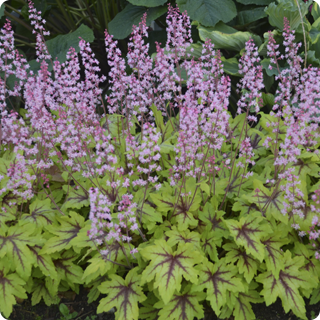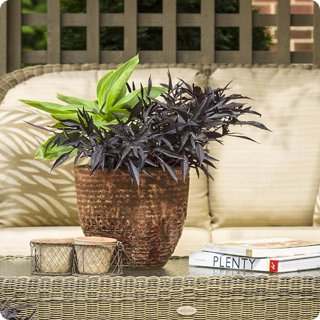SHADOWLAND® ‘Empress Wu’
Hosta
Grow the Biggest Hosta on the Block!
- High impact focal point for shade gardens
- Forms a gigantic mound of huge, leathery green leaves
- Garners more oohs ‘n ahhs than any other hosta
- Summertime blooms attract pollinators
- Grows 3-4′ tall x 5-6′ wide in about five years
- 3′-4′ tall x 5′-6′ spread
- Perennial in USDA Zones 3-9
- Pronounced “HAH-stuh”
Hosta collectors all know—‘Empress Wu’ is the largest known hosta in commerce today. It’s a must-have variety for them and anyone looking to make a statement in their shade garden. This royal hosta develops over time into a massive mound of huge leaves that can measure as much as 1 ½ feet wide and long. Sure, they’re solid green, but in this case, it’s the size that counts. By year five when the plant matures, your garden guests will all be taking selfies with your ‘Empress Wu’.
Adding to its great aura, pale reddish violet flowers appear in early to midsummer on tall stalks above the foliage in plain view of pollinating bees and hummingbirds which often stop by for a snack.
If you love the look of ‘Empress Wu’ but have a penchant for variegation, try its cousin, ‘Wu La La’.
HOW TO GROW SHADOWLAND® ‘EMPRESS WU’ HOSTA
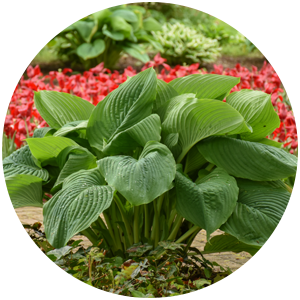
Planting
When choosing a spot to plant ‘Empress Wu’ hosta, consider that it prefers to grow in morning sun or dappled sun throughout the day. Afternoon sun can be too strong and burn the foliage, especially in warm climates.
The first place you might consider planting your new hosta is under a tree. If the tree is deeply rooted, like an oak or hickory, there will be plenty of room for the hosta’s roots to grow. But maples, birches and spruce trees have broad, shallow root systems that could outcompete the hosta for root space and make it grow much slower. Consider root competition when finding the right spot.
‘Empress Wu’ hosta grows best in humus-rich soil that stays moist and well-drained, but it will also grow reasonably well in sandy and clay soils. If you plan to grow it in a container for the first few years of its life, use a good quality potting soil with a bit of slow release plant food mixed in to help it get off to a strong start.
This hardy perennial isn’t too fussy about when you plant it. Cooler spring and fall weather is ideal, but if summer is your only option, just be sure to plant it in the shade and keep the soil moist through the warmest months while its roots get established.
When planting, dig the hole about twice as wide but just as deep as the container it is growing in. If your soil is light in color–indicating it doesn’t contain much organic matter–add several handfuls of humus, compost or aged manure when you backfill the hole. That will provide extra nutrients and water-holding capacity to the soil.

Maintenance
Hostas require very little maintenance during the growing season. They need little more than some shade, good soil and moisture to flourish all on their own.
Watch for rabbits in spring–this is their favorite time of year to munch on hostas. Just as their pointed tips emerge from the soil, a hungry bunny may come along and nip them off. It won’t hurt the hosta but once its leaves unfurl, you’ll see the bunny’s teeth marks. Avoid this by applying animal repellent on your hostas in early spring just as they start to come up.
If deer are an issue in your garden, consider growing more deer resistant plants or plan to protect your hostas with animal repellent or fencing. Taller, thinner leaved cultivars are more prone to damage simply because they are easier for the deer to eat.
During wet weather, slug populations can multiply quickly. If you start seeing holes in your hosta leaves, it’s a sure sign that they have moved in. Here is an article to help you “slug it out” with these pesky creatures.
Hostas should be cut back in fall once their foliage has gone to sleep for the season. Remove the spent foliage from the garden bed and dispose of it to help avoid future slug damage around the plants.
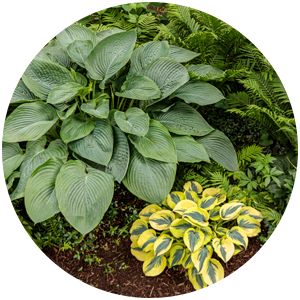
Companion plants
Plants that thrive in the shade provide a scintillating surprise for visitors to your garden. Because of its dramatic scale, ‘Empress Wu’ works best as a backdrop for your other shade plants and as an eye-catching focal point in the landscape. When looking for companion plants, choose those that prefer similar cultural conditions including partial to full shade and rich, moist soil. Your local garden center likely has a separate section for shade perennials where you’ll find all sorts of companions for this royal beauty.
You could plant smaller hosta varieties like ‘Autumn Frost’ nearby to emphasize the mighty scale of your ‘Empress Wu’. In the picture above, see how nicely its bright yellow coloring is enhanced by the solid green backdrop? You might also try planting a grouping of Fun and Games® ‘Eye Spy’ foamy bells at the skirt of ‘Empress Wu’. While she is still arising from her winter slumber, ‘Eye Spy’ will entertain you and the early pollinators with its masses of bubblegum pink blossoms.
If you decide to grow your young ‘Empress Wu’ hosta in a container for its first few years, it doesn’t have to look lonely. Stick a single 4-inch pot of Sweet Caroline Raven™ sweet potato vine in with it and your pot will look nice and full all summer long.
top 3 reasons to
grow ‘Empress Wu’ Hosta
IMPRESS YOUR NEIGHBORS
There’s no doubt—this hosta stands out from a crowd. Spreading up to six feet across, you’ll only need one to make a memorable impression.
SHOWY IN SHADE
While many interesting perennials need full sun to thrive, this remarkable hosta is at its very best in cool shade.
ATTRACTS POLLINATORS
Bumble bees and hummingbirds will be frequent guests when this hosta’s trumpet-shaped blossoms are perched above the foliage.
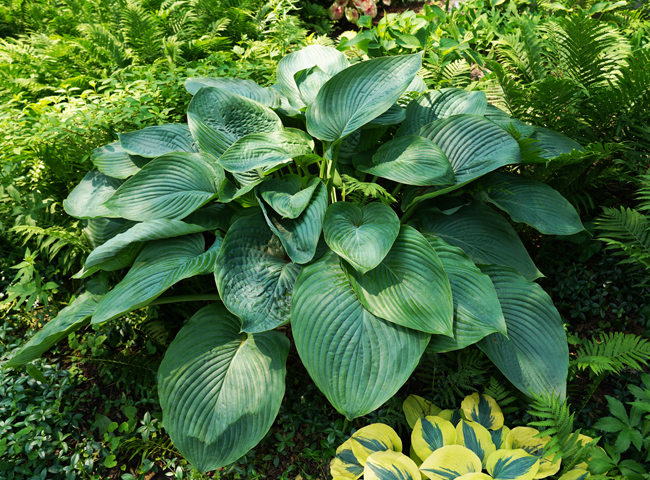
Shadowland® ‘Empress Wu’ Hosta USPP 20,774, Can 4,240

